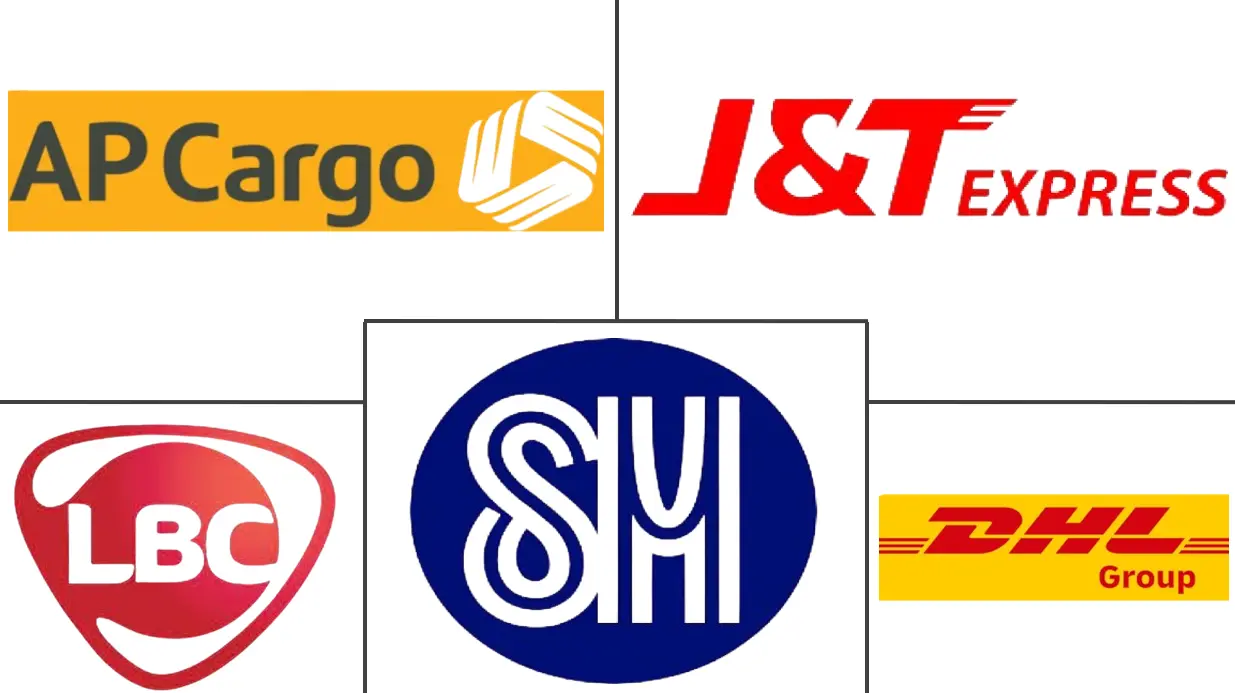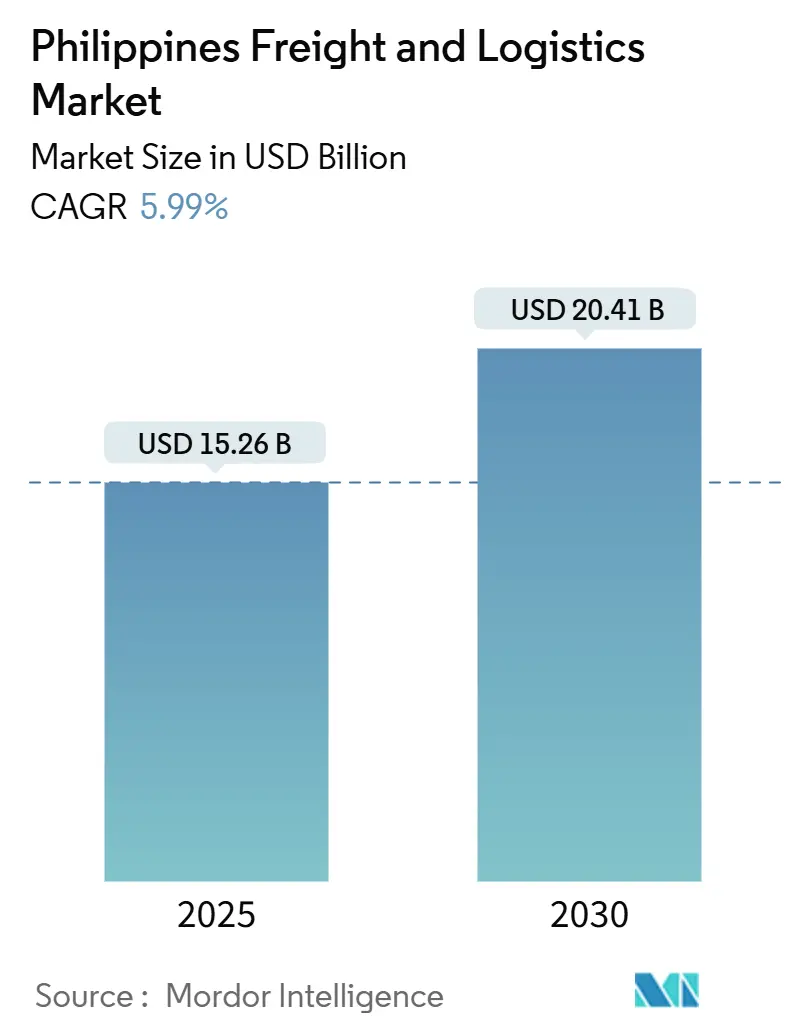
Philippines Freight And Logistics Market Analysis by Mordor Intelligence
The Philippines freight and logistics market size is estimated at USD 15.26 billion in 2025, and is expected to reach USD 20.41 billion by 2030, at a CAGR of 5.99% during the forecast period (2025-2030). The expansion gains momentum from the PHP 8.8 trillion (USD 158.19 billion) “Build, Better, More” program, liberalized foreign‐ownership rules, and increased e-commerce demand. Road freight remains the backbone of the network, yet port automation and air-cargo upgrades are reshaping modal decisions. Foreign investors are entering through joint ventures that pair global expertise with local reach, accelerating technology adoption across warehousing, freight forwarding, and last-mile delivery. Government-led digital connectivity policies, including a USD 750 million World Bank loan, complement physical infrastructure and allow smaller operators to adopt platform business models.
Key Report Takeaways
- By end user industry, wholesale and retail trade held 30.79% of the Philippines freight and logistics market share in 2024 and is expected to advance at a 6.59% CAGR between 2025-2030.
- By logistics function, the freight transport segment led with 63.34% of the Philippines freight and logistics market size in 2024, while the courier, express, and parcel (CEP) segment is expected to grow the fastest 6.89% CAGR between 2025-2030.
- By freight transport mode, road freight transport accounted for 67.65% revenue share in 2024; air freight transport is projected to expand at a 7.63% CAGR between 2025-2030.
- By CEP segment, domestic deliveries captured 65.06% of the revenue share in 2024; international CEP is projected to advance at a 7.14% CAGR between 2025-2030.
- By warehousing type, non-temperature controlled space commanded 91.68% revenue share in 2024; temperature controlled facilities are expected to expand at 6.83% CAGR between 2025-2030.
- By freight forwarding mode, sea and inland waterways freight forwarding led with 58.29% revenue share in 2024 and is projected to rise at a 5.86% CAGR between 2025-2030.
Philippines Freight And Logistics Market Trends and Insights
Drivers Impact Analysis
| Driver | (~) % Impact on CAGR Forecast | Geographic Relevance | Impact Timeline |
|---|---|---|---|
| Infrastructure "Build Build Build 2" program boosting road and port capacity | +1.7% | National; Luzon Economic Corridor | Medium term (2–4 years) |
| Expansion of cold-chain capacity for fisheries and agrifood exports | +1.2% | Agricultural provinces | Medium term (2–4 years) |
| Port modernization and automation PPPs (e.g., MICT) cutting vessel turn-around time | +0.9% | Manila, Cebu, Davao | Short term (≤ 2 years) |
| Foreign-ownership liberalization (Public Service Act amendments) attracting FDI in 3PLs | +0.8% | Urban centres | Long term (≥ 4 years) |
| Surging B2C e-commerce requiring same-/next-day logistics across Luzon urban corridors | +0.7% | Metro Manila and Luzon corridors | Short term (≤ 2 years) |
| Growing manufacturing sector driving industrial logistics demand | +0.6% | National, with concentration in industrial zones | Medium term (2-4 years) |
| Source: Mordor Intelligence | |||
Infrastructure “Build, Better, More” Program Boosting Road and Port Capacity
The PHP 8.8 trillion (USD 158.19 billion) flagship pipeline has completed 11,945 km of road projects and is constructing 15,769 km more, slashing Luzon travel times by up to 50% and linking Batangas, Manila, Clark, and Subic into a unified corridor[1]Department of Public Works and Highways, “Build, Better, More Flagship Project Status,” dpwh.gov.ph. Harmonized road, port, and rail upgrades promise lower transit times, tighter supply-chain scheduling, and higher truck turns. Investors are fast-tracking distribution hubs near the new expressways to secure first-mover advantages. Contract logistics providers are aligning network designs with the expressway map to cut empty back-haul miles. As multimodal nodes emerge, operators that integrate trucking with coastal shipping gain cost leverage over single-mode rivals.
Port Modernization and Automation PPPs (e.g., MICT) Cutting Vessel Turn-Around Time
Manila International Container Terminal (MICT) applied an N4 3.4 operating system and yard upgrades worth PHP 15 billion (USD 269.64 million), slicing berth time by 35% and raising Manila’s 2023 throughput to 5.06 million TEUs. Quicker clearances reduce demurrage penalties and lower inventory buffers for shippers. Forwarders embed real-time port data in booking tools, letting exporters choose sailings with minimal congestion. Equipment automation unlocks longer gate hours, which supports night-time drayage and eases daytime traffic, benefiting last-mile fleets working tight delivery windows.
Foreign-Ownership Liberalization Attracting FDI in 3PLs
The amended Public Service Act now allows 100% foreign equity in shipping and transport, triggering immediate deal flow such as A.P. Moller Capital’s 40% stake in AC Logistics[2]United Nations Conference on Trade and Development, “Philippines Public Service Act Amendments,” unctad.org. Fresh capital funds modern warehouse management systems, route-optimization software, and fleet telematics. International best practices are spread through joint operating teams, lifting sector service levels. Mid-sized local players gain new exit pathways via partial divestments, encouraging consolidation and wider geographic coverage.
Surging B2C E-Commerce Requiring Same-/Next-Day Logistics Across Luzon Urban Corridors
E-commerce sales are forecast to hit USD 22.48 billion in 2025, pushing fulfilment operators to set up micro-warehouses near Metro Manila shoppers[3]Bangko Sentral ng Pilipinas, “2025 E-commerce Payments Landscape,” bsp.gov.ph. Hub-and-spoke models mix automated sort centers with motorcycle couriers that navigate dense streets. Time-certain delivery promises drive the adoption of data-driven order batching and dynamic routing. Brands are testing dark-store concepts, turning retail space into instant-pick sites. Parcel carriers with API integration into multiple marketplaces win share as online sellers demand plug-and-play logistics.
Restraints Impact Analysis
| Restraint | (~) % Impact on CAGR Forecast | Geographic Relevance | Impact Timeline |
|---|---|---|---|
| Under-developed rail freight network limiting multimodal efficiency | -0.7% | National, particularly affecting inter-island connectivity | Long term (≥ 4 years) |
| Severe road congestion in Metro Manila inflating last-mile costs | -0.9% | Metro Manila and surrounding urban areas | Medium term (2-4 years) |
| Fragmented SME-dominated sector with low digitalization | -0.5% | National, with greater impact in provincial areas | Medium term (2-4 years) |
| High typhoon and seismic risk disrupting supply chains | -0.6% | National, with higher impact in coastal and fault line areas | Short term (≤ 2 years) |
| Source: Mordor Intelligence | |||
Under-Developed Rail Freight Network Limiting Multimodal Efficiency
Freight rail remains negligible despite a PHP 135.4 billion (USD 2.43 billion) transport budget, of which only PHP 1.17 billion (USD 21.03 million) targets rail transport in 2024. Heavy industries lose scale benefits when bulk cargo must shift to trucks. Logistics costs run 20–30% higher than regional peers, the World Bank notes. Private consortia are evaluating dedicated cargo spurs between economic zones and ports, but land-acquisition hurdles persist. Operators experimenting with road-rail containers position themselves for first-mover gains once corridors break ground.
Severe Road Congestion in Metro Manila Inflating Last-Mile Costs
Daily traffic losses reached PHP 3.5 billion (USD 62.92 million) in 2024 and may climb to PHP 5.4 billion (USD 97.07 million) by 2035 without new transit options. Delivery fleets achieve fewer drops per shift, raising the cost per parcel by up to 35%. Carrier strategies now include off-peak night runs, consolidation centers on the urban fringe, and electric two-wheelers for narrow streets. A Japan-backed railway master plan underscores the urgency of a modal shift, but implementation remains gradual. Firms able to optimize route algorithms with live congestion feeds sustain better on-time metrics, reinforcing customer stickiness.
Segment Analysis
By End User Industry: Wholesale–Retail Coupling With Manufacturing Fuels Demand
Wholesale and retail trade represented 30.79% of 2024 revenue with a projected CAGR (2025-2030) of 6.59%, mirroring the nation’s consumption-driven economy. Manufacturing is linked to the expansion of semiconductor back-end plants, personal-care production, and beverage lines that depend on predictable inbound raw-material streams. Construction absorbed the infrastructure push, buoyed demand for bulk aggregates, steel, and cement. Agriculture, fishing, and forestry are expected to grow with cold chain upgrades, facilitating longer shelf life and better farm-gate revenue.
Retailers and factories alike now seek real-time inventory snapshots and coordinated replenishment, prompting logistics partners to embed IoT sensors and API gateways. Maersk’s fulfilment-center investments under CREATE MORE tax incentives illustrate how integrated ocean-to-warehouse services resonate with multinational manufacturers. Oil, gas, and mining require specialized heavy-haul rigs and hazardous-cargo compliance, while the fast-growing “others” band, healthcare, education, and reverse logistics, creates opportunities for operators proficient in high-value, high-service niches within the Philippines freight and logistics market.
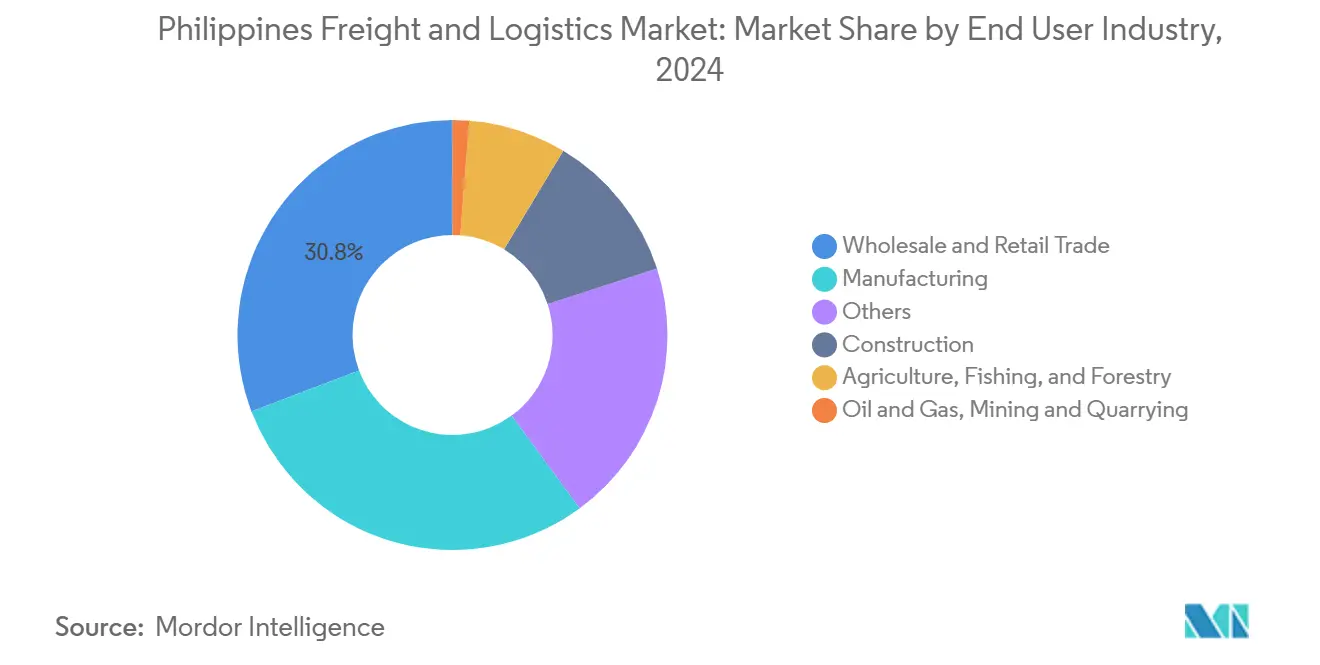
Note: Segment shares of all individual segments available upon report purchase
By Logistics Function: Freight Transport Retains Primacy as CEP Scales Up
Freight transport generated 63.34% of the 2024 total revenue, underscoring its role as the backbone of the Philippines freight and logistics market. Trucking, coastal shipping, air cargo, and pipelines underpin national supply-chain continuity across more than 7,600 islands. Courier, Express, and Parcel (CEP) segment, though a smaller slice today, is clocking a 6.89% CAGR between 2025-2030 as social-commerce sellers and marketplace giants promise next-day delivery nationwide. The warehousing and storage segment and freight forwarding form critical links that synchronize upstream production with downstream retail intake.
Momentum inside CEP is redrawing competitive boundaries: pure-play parcel firms are integrating digital wallets, while traditional 3PLs adopt crowdsourced rider models to protect share. Warehouse operators deploy robotics and construct multi-temperature zones to attract pharmaceutical and agrifood tenants. Forwarders leverage port automation and foreign-capital partnerships to bundle customs brokerage with value-added services such as kitting and reverse logistics. Collectively, these shifts confirm an ecosystem moving toward end-to-end orchestration rather than siloed execution in the Philippines freight and logistics market.
By Courier, Express, and Parcel: E-commerce Reshapes Delivery Dynamics
Domestic CEP services commanded 65.06% revenue in 2024 and remain pivotal to the Philippines freight and logistics market. Operators add micro-fulfilment centers inside Metro Manila malls to position inventory closer to buyers. Mobile tracking, parcel lockers, and flexible delivery windows enhance customer engagement.
International CEP is projected to outpace domestic services with a 7.14% CAGR between 2025-2030. ASEAN cross-border orders rise for fashion and beauty products, while SME exporters ship niche goods to diaspora markets. Services integrate customs-clearance APIs to shave clearance times. Carriers pair flights with regional ground hubs, giving Filipino sellers end-to-end visibility and positioning the Philippines freight and logistics market size for wider trade participation.
By Warehousing and Storage: Cold Chain Investment Heats Up
Non-temperature-controlled space dominated at 91.68% in 2024, anchoring multiclient storage for retail and manufacturing. Developers cluster new facilities along the North Luzon Expressway interchanges to cut urban haul costs. Automation, mezzanine floors, and LED lighting improve m³ efficiency, raising yields in the Philippines freight and logistics market.
Temperature-controlled warehousing is expected to grow at a 6.83% CAGR (2025-2030) as food, pharma, and agrifood exporters demand stringent handling. Government build-operate schemes incentivize private developers with tax perks, accelerating solar-assisted cold stores. New multi-temperature designs host frozen, chilled, and ambient bays in one building, giving 3PLs flexibility. The segment’s rising revenue share demonstrates how differentiated services lift margins while supporting food-security goals within the Philippines freight and logistics industry.
By Freight Transport: Road Networks Anchor a Multimodal Pivot
Road freight transport held 67.65% of segment turnover in 2024, reflecting reliable truck access to even the smallest roll-on/roll-off ports. Air freight transport is the fastest climber at 7.63% CAGR between 2025-2030, spurred by electronics exports, vaccine deliveries, and a doubling of Clark International Airport’s freight apron. Sea and inland waterways freight transport is enabling cost-efficient inter-island moves, while pipelines manage a minor share of petroleum flow.
Hybrid transport models are taking hold: manufacturers book truck-to-vessel routings that shave fuel expense yet retain schedule predictability. The Department of Transportation’s forthcoming Intermodal Terminals Code aims to harmonize handling protocols across truck yards, barge wharves, and air cargo sheds. Automated gates at Manila International Container Terminal have lifted truck cycles, and electronic cargo release has lowered demurrage outlays. The absence of freight rail continues to inflate inland drayage costs, but 3PLs anticipate new rail spurs to economic zones under the North–South Commuter Railway program will eventually unlock sizable efficiency gains in the Philippines freight and logistics market.
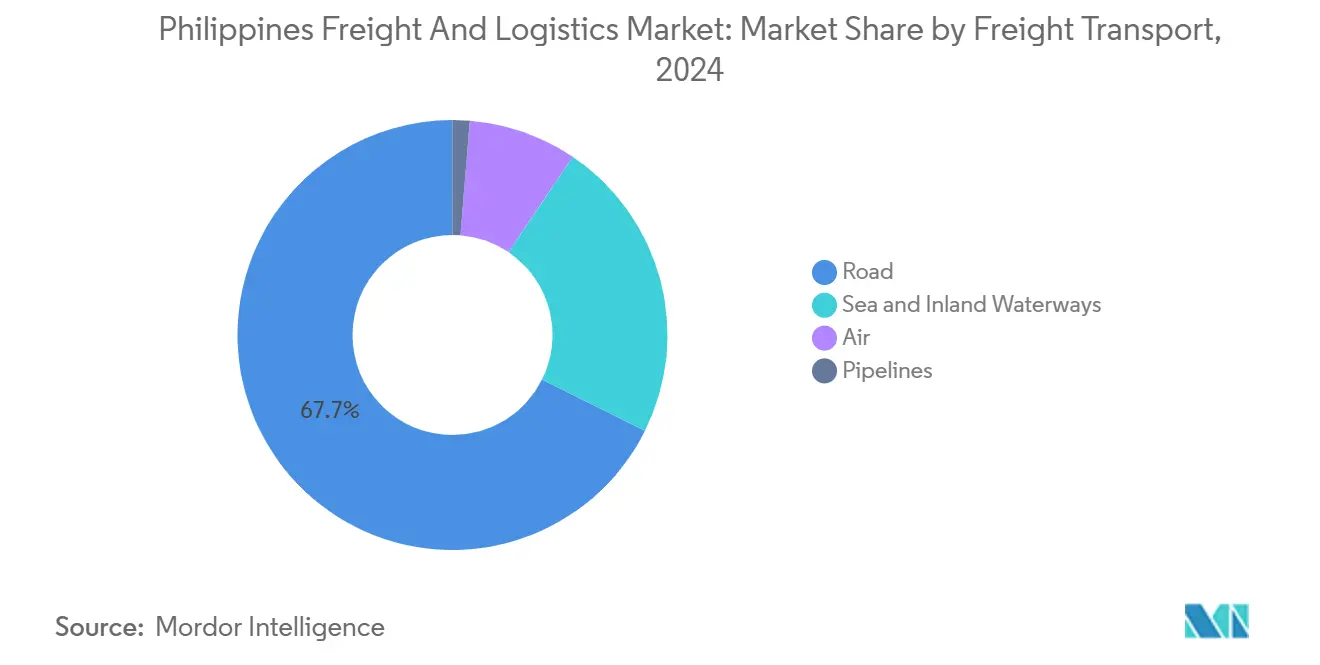
Note: Segment shares of all individual segments available upon report purchase
By Freight Forwarding: Maritime Dominance Reflects Archipelagic Reality
Sea and inland waterways freight forwarding secured 58.29% of 2024 forwarding revenue with a projected CAGR (2025-2030) of 5.86% and will likely preserve leadership, sustained by dredging, quay cranes, and digital port-community systems. Forwarders leverage vessel schedule reliability to build guaranteed space programs for electronics shippers.
Air freight forwarding positions itself for high-value cargoes. Clark Airport’s freighter zone and Cebu’s runway extension attract integrators seeking night flight slots. Multimodal freight forwarding in the “others” bracket combines trucking and feeder shipping, creating one-stop propositions for SMEs. Foreign entrants deploying global booking platforms expand choice and transparency, widening the Philippines freight and logistics market share for integrated solutions.
Geography Analysis
Luzon hosts the greatest concentration of distribution centers, ports, and airports, anchoring nearly two-thirds of national freight flows. The PHP 2.126 trillion (USD 38.22 billion) Luzon Economic Corridor, connecting Batangas Bay, Manila, Clark, and Subic, upgrades road, rail, and maritime links and strengthens semiconductor supply-chain resilience[4]Bases Conversion and Development Authority, “Luzon Economic Corridor Overview,” bcda.gov.ph. Private developers build inland container depots near new expressway exits, cutting drayage time to Manila ports. Retail distribution nodes in Cavite and Laguna support same-day fulfilment for NCR shoppers, and Clark’s air-cargo zone offsets airport slot scarcity in the capital.
The Visayas region gains share through port concessions such as the Visayas Container Terminal in Iloilo, run under a 25-year ICTSI contract. Regional economic planners promote roll-on/roll-off links among Cebu, Negros, and Panay, easing inter-island transfers. Agritourism drives specialized logistics for perishables and hospitality supplies. Cold-chain investment clusters around Cebu’s Mactan Airport, preparing seafood shippers for direct export lanes.
Mindanao’s agricultural output drives demand for export-grade handling, but logistics costs remain 30% above Luzon averages due to infrastructure gaps. The Philippine Ports Authority earmarked PHP 1.8 billion (USD 32.36 million) to modernize Davao and General Santos wharves, aiming to lift banana and tuna shipment reliability. Peace-and-order concerns in some provinces add risk premiums that larger insurers and carriers can better absorb. As ports upgrade and road links improve, Mindanao gains the confidence of foreign buyers seeking diversified sourcing, positioning the Philippines freight and logistics market for broader geographic balance.
Competitive Landscape
The market features a mix of global integrators, regional groups, and thousands of SMEs, resulting in high fragmentation. A.P. Moller-Maersk’s 40% acquisition of AC Logistics injects global standards into domestic contract logistics, showcasing how liberalized equity rules attract large-scale capital. Integrated carriers combine warehousing, trucking, and customs brokerage to cross-sell across service lines. SMEs defend niches through specialized fleet types and strong community ties, but face digitalization lags.
Technology investment distinguishes frontrunners. ICTSI deployed 5G at Manila International Container Terminal to synchronize crane, truck, and gate operations. Parcel networks incorporate AI-driven volume forecasting to stage trailers and allocate riders. Cold-chain specialists adopt IoT sensors for temperature audit trails, giving exporters compliance assurance. Foreign forwarders opening local offices introduce real-time booking portals, nudging incumbents toward similar transparency.
White-space opportunities arise in integrated e-commerce fulfilment, healthcare logistics, and green supply-chain services. Renewable-powered cold stores, shared truck-load marketplaces, and multimodal corridors feature prominently in investment pipelines. Policy support for digital trade documentation further levels the field, allowing tech-savvy entrants to challenge asset-heavy incumbents in selected lanes of the Philippines freight and logistics market.
Philippines Freight And Logistics Industry Leaders
-
SM Investments Corp. (including 2GO Group)
-
LBC Express Holdings, Inc.
-
DHL Group
-
J&T Express
-
AP Cargo
- *Disclaimer: Major Players sorted in no particular order
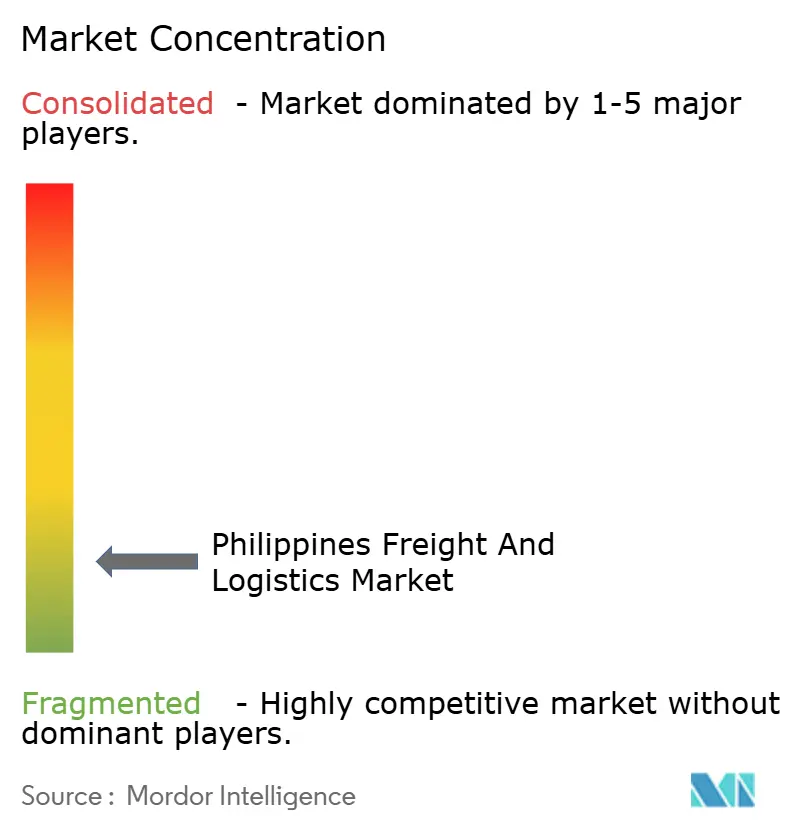
Recent Industry Developments
- April 2025: DSV A/S finalized the EUR 14.3 billion (USD 15.78 billion) takeover of DB Schenker, creating the world’s largest freight forwarder and broadening service scope in the archipelago.
- March 2025: A.P. Moller Capital acquired a 40% stake in AC Logistics to expand contract, cross-border, cold-chain, and project logistics services across the Philippines.
- November 2024: A.P. Moller - Maersk opened the Philippines' largest distribution center in Laguna, spanning 46,000 m² with an investment of approximately USD 25 million. The facility combines automation, smart warehouse systems, and eco-friendly design to boost Maersk’s service for e-commerce, retail, and multinational supply chains.
- July 2024: FedEx announced plans to expand its Philippines gateway facility to support accelerating e-commerce growth, with the expansion expected to increase sorting capacity by 40% and enhance service reliability for both domestic and international shipments.
Research Methodology Framework and Report Scope
Market Definitions and Key Coverage
Our study defines the Philippines freight and logistics market as gross revenue earned from moving and handling goods within, into, and out of the country through road, sea and inland waterway, air, and rail freight transport, freight forwarding, courier-express-parcel, warehousing, and related third-party value-added services. We value flows at contractual prices before VAT and after customary trade discounts.
Scope Exclusions: Passenger transport, purely captive in-house logistics, and standalone warehouse real-estate rents are outside this study.
Segmentation Overview
- End User Industry
- Agriculture, Fishing, and Forestry
- Construction
- Manufacturing
- Oil and Gas, Mining and Quarrying
- Wholesale and Retail Trade
- Others
- Logistics Function
- Courier, Express, and Parcel (CEP)
- By Destination Type
- Domestic
- International
- By Destination Type
- Freight Forwarding
- By Mode of Transport
- Air
- Sea and Inland Waterways
- Others
- By Mode of Transport
- Freight Transport
- By Mode of Transport
- Air
- Pipelines
- Road
- Sea and Inland Waterways
- By Mode of Transport
- Warehousing and Storage
- By Temperature Control
- Non-Temperature Controlled
- Temperature Controlled
- By Temperature Control
- Other Services
- Courier, Express, and Parcel (CEP)
Detailed Research Methodology and Data Validation
Primary Research
Interviews with freight forwarders, 3PL managers, airline cargo chiefs, e-commerce retailers, and regulators across Luzon, Visayas, and Mindanao refine modal shares, rate corridors, and short-term demand signals that desktop sources alone cannot reveal.
Desk Research
We start by downloading official time-series from the Philippine Statistics Authority, Bureau of Customs, Department of Transportation traffic counts, and Philippine Ports Authority tonnage logs. We then enrich them with World Bank Logistics Performance Index scores and papers from the Supply Chain Management Association of the Philippines. Congressional budget briefs and port operator notices clarify capacity pipelines and tariff revisions. Proprietary sweeps through D&B Hoovers and Dow Jones Factiva let our team cross-check carrier revenues and deal news. These examples show depth, while many other references support verification.
A second pass tracks e-commerce parcel volumes, diesel price trends, warehouse vacancy, and peso-dollar movements so demand drivers and cost modifiers entering the model rest on verified public indicators.
Market-Sizing & Forecasting
Our analysts launch a top-down build that reconstructs 2024 freight expenditure from supply-use tables, port and road ton-kilometer data, and average tariff surveys. Selective bottom-up checks, supplier roll-ups, and sampled average selling price multiplied by volume fine-tune informal and cross-border flows. Core variables such as GDP growth, infrastructure outlays, parcel counts, diesel index, and cold-chain capacity drive a multivariate regression projecting values through 2030. Gaps in evidence are bridged with three-year moving averages from comparable ASEAN corridors.
Data Validation & Update Cycle
Outputs face variance tests against alternate trade, tax, and carrier capacity series. Deviations above three percentage points trigger analyst review and call-backs. Reports refresh every twelve months, and interim updates follow major policy shifts or industry deals.
Why Mordor's Philippines Freight and Logistics Baseline Stand Firm and Reliable
Published estimates often differ because firms adopt varying service boundaries, exchange-rate cut-offs, and refresh speeds. We flag those gaps up front so users are not blindsided later.
Key gap drivers include whether supply-chain management fees are counted, how informal micro-couriers are treated, the multiplier applied to booming e-commerce, and the currency date used.
According to Mordor Intelligence, our consistent scope, mid-year peso-to-USD conversion, and disciplined annual update cadence give planners a dependable anchor.
Benchmark comparison
| Market Size | Anonymized source | Primary gap driver |
|---|---|---|
| USD 15.26 bn (2025) | Mordor Intelligence | |
| USD 18.03 bn (2024) | Regional Consultancy A | Counts supply-chain fees and higher e-commerce multiplier |
| USD 19.70 bn (2024) | Global Consultancy B | Uses fixed logistics-to-GDP ratio, ignores informal flows |
| USD 19.16 bn (2023) | Trade Journal C | Adds passenger baggage handling and pre-pandemic FX |
Taken together, our disciplined scope selection and yearly refresh deliver a transparent, repeatable baseline that decision-makers can trust while still leaving room for dialogue when unique planning assumptions are required.
Key Questions Answered in the Report
What is the current size of the Philippines freight and logistics market?
The Philippines freight and logistics market size is valued at USD 15.26 billion in 2025 and is projected to reach USD 20.41 billion by 2030.
Which logistics function holds the largest share?
Freight transport segment dominates with 63.34% of market revenue in 2024.
Which freight transport mode is growing the fastest?
Air freight transport is forecast to expand at a 7.63% CAGR from 2025 to 2030 as e-commerce and high-value exports scale.
How quickly is the cold-chain segment expanding?
Temperature-controlled warehousing capacity is increasing at a 6.83% CAGR (2025-2030), driven by agrifood exports and pharmaceutical demand.
What is the primary challenge affecting last-mile costs in Metro Manila?
Severe road congestion increases delivery costs by up to 35%, prompting carriers to adopt night-time routing, micro-hubs, and two-wheeler fleets.
What impact does foreign-ownership liberalization have on the sector?
The amended Public Service Act allows 100% foreign equity in shipping and logistics, accelerating capital inflows and technology transfer to 3PLs.
Page last updated on:
